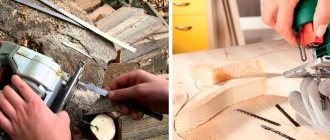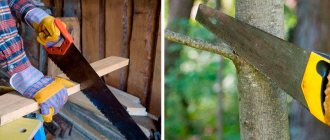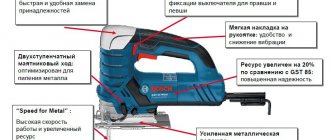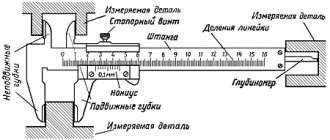Good afternoon, dear readers of the online store blog.
The saw blade is the most important working component in a jigsaw. How accurate, fast and high-quality the cut will be depends on it. Requirements for files for a manual jigsaw may be different, depending on what tasks they are selected for. For example, for crafts made from plywood, cutting laminate, metal, and complex shapes, a thin but slow cut is important; For working with wood or chipboard, you can use quick and rough. The job will be completed much faster if you choose the right saw blade. In this article, we will talk about the types and features of hand jigsaw files, how to choose them correctly, and also share several life hacks on what you can use to make files in your home workshop.
Features of files
If your saw blade has become unusable and you are about to go to the store, then we advise you to first understand the basic terminology regarding your future purchase. Below we will talk about several main features of files.
Any manual jigsaw blade that you find in the store has a TPI setting of “Tooth Pro Inch” (the number of teeth per inch is 2.5 cm). Note that the higher this indicator, the neater the cutting line will be. However, the work process itself will become slower. Thus, the lower, the faster, but less accurate. The average TPI is 15 teeth per inch, or 6 per 1 cm.
The tooth set is another important indicator of the saw, which prevents the saw blade from jamming in the material and facilitates the sawing process. It is worth paying attention to this, because not every file found on sale has this property.
Voting for the best set of jigsaw files
What set of jigsaw files would you choose or recommend?
BOSCH 2607011437
29.41 % ( 25 )
BOSCH 2607011170
21.18 % ( 18 )
DeWALT DT 2294
10.59 % ( 9 )
Makita A-86898
18.82 % ( 16 )
DeWALT DT 2296
7.06 % ( 6 )
Hammerflex JG WD-PL 204-903
3.53 % ( 3 )
Diold T101V
4.71 % ( 4 )
RUNEX HSS T118B
0.00 % ( 0 )
HYUNDAI T119B 204107
0.00 % ( 0 )
Types of blades for a manual jigsaw for wood
Hand jigsaw files, designed for cutting wood, taking into account the structure of their teeth, are divided into five types, each of which has its own specifics. Let's look at all types in more detail, taking into account the tasks that each of them performs.
Standard. A commonly used wood jigsaw blade has equally spaced teeth of the same size and direction. Files with such a cutting part leave an undesirable curved line and are intended for rough cutting of wood.
A blade with double teeth is less common. A file with a small gap after each pair of teeth has a low speed, but the efficiency of the process is high. This file practically does not leave sawdust on the surface of the material and almost does not overheat. It can be used when performing “filigree” work.
A file with a missing tooth significantly increases the speed of cutting material due to a slight loss of quality. Like the previous type, this saw blade hardly heats up, copes well with sawdust and does not get stuck during operation. Can be used for straight and decorative cutting of wood or plastic.
Blades for a manual jigsaw with reverse (reverse) teeth are used less frequently than typical ones and, unlike them, are unique in that they cut without chipping from the underside of the workpiece. They cope well with delicate, delicate woodworking. If you consider yourself an experienced specialist in working with a hand jigsaw, then this type of file is just for you; we do not recommend it for use by beginners.
The spiral type is the rarest, which is most often used for figured cutting. Round files for a hand jigsaw are quite difficult to handle, so they are more in demand for machine tools. The uniqueness of this type of blade lies in the possibility of a sharp change in direction during the sawing process.
What to look for before buying files
The characteristics and capabilities of the files can be found from the markings. A specific designation standard has not been developed, but most manufacturers try to use similar designations. Most often, markings consist of a combination of numbers and letters.
Markings on the jigsaw file
The first letter usually identifies the shank type (U,T). The number following it symbolizes the length of the file:
- 1 - up to 75 mm;
- 2 - from 75 to 90 mm;
- 3 - from 90 to 150 mm;
- 7 - from 150 mm.
Then follows the letter from A to D. A is the smallest teeth, D is the largest. The last letter of the marking is additional information (R - reverse teeth, F - bimetal, O - figured cutting, etc.).
The scope of application of the files can also be determined by the color of the shank:
- black - universal file;
- gray - wood;
- blue - metal;
- red - synthetic materials;
- white - metal and wood.
The material used to make the file is usually indicated at the transition from the shank to the working area. Combinations of letters indicate the type of steel:
- HCS - high carbon;
- CV – chrome vanadium;
- HSS – high speed;
- HM – tungsten carbide.
In addition, most files have inscriptions explaining the scope of use of the files, as well as some of their characteristics.
Buying files in a set is an excellent option to provide yourself with a supply of consumables for a jigsaw. In this case, you can pay attention both to sets with a large number of different files, and to those in which one or two types of blades are presented, but in large quantities. The first option is preferable for the home craftsman, the second is suitable for professional use.
Video - Comparison of jigsaw files, which are the best and which are best to buy
How to choose a good file
Having well organized your workplace and having reliable, high-quality blades on hand that will not deteriorate, break, or tear from the first wrong action, the process of sawing with a manual jigsaw can be a pleasure. In order not to waste your time and nerves, it is best to figure out how not to fall for a fake when choosing a quality file. Of course, we advise you to purchase products from a trusted brand. Reliable saw blades for hand jigsaws are produced by companies such as Bacho, FIT, Stanley and Kraftool. When purchasing components from these brands on construction markets, you risk buying a fake. Therefore, it is better to purchase files from large, trusted construction stores.
Types of jigsaw blade shanks
The first thing you should pay attention to when choosing a jigsaw file is the type of shank. And this is logical: if your tool is not designed to work with this variety, then you simply will not be able to use the new blade. There really aren't that many options:
T-shank.
It is often called “Boschevsky”, since it was this company that developed files with this type of shank. Since BOSCH is the market leader in jigsaws and accessories for them, and other industry giants are trying to switch to this standard, it is not surprising that T-shank files are currently the most common. The T-shank fits most modern jigsaws - Bosch, Makita, Metabo, Hitachi, Skil, AEG, DeWalt, Sparky, Interskol, etc.
U-shank.
The second most popular type of shank is the American standard. This is a universal shank for older models of jigsaws Skil, DeWalt, Wolf, Ryobi, Stayer, Black&Decker, etc. These files are suitable for all jigsaws with block and screw clamps.
Makita shank.
Files with this shank are only compatible with older Makita jigsaw models.
Bosch shank.
It differs from the T-shank only in the presence of a second stop. These files are only suitable for older Bosch models.
The last two types of shanks can already be classified as rarities. Finding such files in domestic stores today is almost impossible.
DIY file
If you have your own workshop, a file can be made from available materials. It won't be difficult. For example, it can be made from a tin can, thick steel wire or guitar string. An ordinary tin can will help you save your budget; the average cost of such a canvas is 35 rubles per piece. A file made of steel wire will perform its function just as well, and will last longer than many cheap fakes. What you need during production and the process itself can be easily found on the Internet.
Canvas dimensions
The capabilities of jigsaw blades are determined not only by the size and shape of the cutting edge. The geometric characteristics of the canvas itself also affect the speed and quality of work. Plus, its dimensions must be selected based on the type and dimensions of the material being processed.
Length
The lengths of jigsaw blades are in the range of 40–250 mm. When choosing a specific length of a jigsaw file, you need to take into account the thickness of the material in the work. It is clear that to cut thick wooden workpieces you need a long saw blade for a wood jigsaw. But if you cut thin sheet materials with a long blade, then due to the possible bending of the metal, it is difficult to obtain an even cut.
Note! When working with long blades, you should understand that the working depth of the cut is affected by the power of the jigsaw.
Width
You need to select the width of the saw blade based on the type of work to be done. For simple sawing, where a straight and even edge is required, wide files are taken. A narrow blade may move during operation, and a straight cutting line will not work.
But when cutting out shapes of varying degrees of complexity, you need to choose narrow jigsaw blades. It is easier to direct them to the side, drawing curved lines.
Thickness
For sawing thin sheet materials, the thickness of the file does not matter much. But when working with thick workpieces, this size affects the quality of the sawn surface. Thin blades will deviate from the perpendicular line during operation, and the cut will be uneven. The thicker the blade, the more even the cut it provides. But there is one caveat - too thick a blade is not suitable for all models of jigsaws. Jigsaws equipped with quick-release devices may not be suitable for thick blades.
Types of files according to purpose
The word jigsaw still evokes associations with wood. And although modern jigsaws are widely used for sawing plastics and metals, the main material for work is still wood and plywood. You also have to think most often about which blades to choose for a jigsaw on wood.
On wood
For general work on wood and its derivatives (plywood, chipboard, MDF), standard saw blades with a gray shank for simple or hard wood are chosen. The dimensions of the blade, the spread and the size of the teeth are selected individually. But sometimes it is necessary to perform work that differs from ordinary sawing.
If speed is important, even at the expense of the quality of the cut, then you need to choose long saws with large teeth and a large pitch. Divorce is also desirable more.
If you need to get an even and smooth cut without chips, then take blades with a small mark or without it at all. Teeth – medium or fine. Materials that have a finishing side (laminate, chipboard) have to be cut upside down. If you want to see the cut from the front side, then you need to choose files with the teeth in the opposite direction (the last letter of the marking is R).
For artistic cutting there should be a narrow blade no wider than 4 mm, small teeth and short length. Compliance with these conditions will allow figure cutting to be carried out at small turning radii.
For metal
An electric jigsaw is still not the most suitable tool for cutting metal. But if necessary, he can handle it if you choose the right file. The teeth of such files are very small and wavy; the blades are made of especially strong alloys, but they also quickly become dull. It is advisable to select files marked specifically for the type of metal you will be working with.
For polymer materials
The file markings contain designations specifically for working with such materials. Ordinary plastic and PVC products can also be sawed with wood blades. In this case, the teeth must be chosen larger and with a larger spread. A small tooth will not only cut, but also melt the material. For plexiglass, it is better to choose a metal fabric with a wavy pattern.
For special materials
These options have their own designation. First of all, it is ceramics. The files for it are made of special alloys, and the teeth are made with a special durable coating.
Also, especially strong coated teeth are required for cutting drywall.
But for soft materials, files without teeth are produced at all. Their cutting edge is a smooth blade, sharpened in a wave-like manner.











